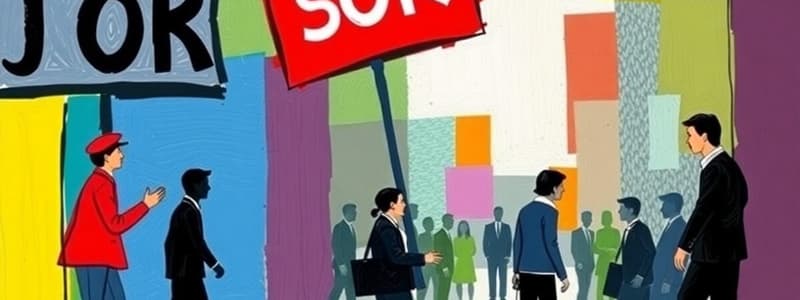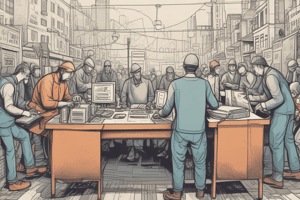Podcast
Questions and Answers
What are the primary economic consequences of unemployment?
What are the primary economic consequences of unemployment?
- Lost incomes, reduced production, and potential damage to human capital. (correct)
- Greater efficiency in resource allocation and increased economic growth.
- Increased government revenue and decreased public debt.
- Increased investment in human capital and higher productivity.
Which of the following best describes the 'working-age population' as defined by the Current Population Survey?
Which of the following best describes the 'working-age population' as defined by the Current Population Survey?
- People aged 16 years and older who are not in jail, hospital, or other institutions. (correct)
- Citizens between the ages of 25 and 54 who have completed their formal education.
- All residents of a country who are eligible to work, regardless of age or institutionalization.
- Individuals aged 18 to 65 who are actively employed or seeking employment.
Which of the following criteria must be met for a person to be counted as unemployed?
Which of the following criteria must be met for a person to be counted as unemployed?
- They must be actively enrolled in a job training program.
- They must be without work, have made specific efforts to find a job within the previous four weeks, or are waiting to be recalled to a job or start a new one within 30 days. (correct)
- They must have been laid off from their previous job due to company downsizing.
- They must be receiving unemployment benefits from the government.
In June 2014, the labor force was 156 million and 9.7 million people were unemployed. What was the unemployment rate?
In June 2014, the labor force was 156 million and 9.7 million people were unemployed. What was the unemployment rate?
How is the employment-to-population ratio calculated?
How is the employment-to-population ratio calculated?
If a country's labor force is 156 million and the working-age population is 248 million, what is the labor force participation rate?
If a country's labor force is 156 million and the working-age population is 248 million, what is the labor force participation rate?
Which of the following is true regarding the official unemployment rate?
Which of the following is true regarding the official unemployment rate?
How are 'discouraged workers' classified in unemployment statistics?
How are 'discouraged workers' classified in unemployment statistics?
Which type of unemployment is considered the most costly?
Which type of unemployment is considered the most costly?
Given a total population of 262.029 million, a labor force of 162.052 million, employed individuals totaling 155.175 million, and 6.877 million unemployed, what percentage of the population is out of the labor force?
Given a total population of 262.029 million, a labor force of 162.052 million, employed individuals totaling 155.175 million, and 6.877 million unemployed, what percentage of the population is out of the labor force?
With 6.877 million unemployed and a total labor force of 162.052 million, what is the unemployment rate?
With 6.877 million unemployed and a total labor force of 162.052 million, what is the unemployment rate?
Which type of unemployment arises from the normal turnover in the labor market, such as people searching for new jobs after the creation and destruction of jobs?
Which type of unemployment arises from the normal turnover in the labor market, such as people searching for new jobs after the creation and destruction of jobs?
What is structural unemployment?
What is structural unemployment?
A worker is laid off during a recession but is rehired when the economy begins to recover. What type of unemployment did this worker experience?
A worker is laid off during a recession but is rehired when the economy begins to recover. What type of unemployment did this worker experience?
Which of the following describes seasonal unemployment?
Which of the following describes seasonal unemployment?
What conditions define 'full employment'?
What conditions define 'full employment'?
Which factors can influence the natural unemployment rate?
Which factors can influence the natural unemployment rate?
What are some potential social effects of high unemployment?
What are some potential social effects of high unemployment?
Which strategies can potentially help reduce unemployment?
Which strategies can potentially help reduce unemployment?
How does prolonged unemployment affect a person's job prospects?
How does prolonged unemployment affect a person's job prospects?
How does the U.S. Bureau of Labor Statistics (BLS) view the official unemployment rate?
How does the U.S. Bureau of Labor Statistics (BLS) view the official unemployment rate?
Which of the following accurately calculates the labor force participation rate?
Which of the following accurately calculates the labor force participation rate?
What defines the term 'marginally attached worker'?
What defines the term 'marginally attached worker'?
What characterizes structural unemployment, and why does it typically last longer than frictional unemployment?
What characterizes structural unemployment, and why does it typically last longer than frictional unemployment?
Which of the following statements correctly describes the relationship between recessions and unemployment rates?
Which of the following statements correctly describes the relationship between recessions and unemployment rates?
In a scenario where the labor force is 162.052 million and the employed population is 155.175 million, what formula accurately calculates the number of unemployed individuals?
In a scenario where the labor force is 162.052 million and the employed population is 155.175 million, what formula accurately calculates the number of unemployed individuals?
How does an increase in unemployment benefits typically affect frictional unemployment?
How does an increase in unemployment benefits typically affect frictional unemployment?
What economic and social challenges are typically associated with elevated levels of unemployment?
What economic and social challenges are typically associated with elevated levels of unemployment?
In June 2014, the employment-to-population ratio was 59 percent. What does that mean?
In June 2014, the employment-to-population ratio was 59 percent. What does that mean?
In June 2014, the labor force participation ratio was 62.9 percent. What does that mean?
In June 2014, the labor force participation ratio was 62.9 percent. What does that mean?
What is the purpose of the unemployment rate?
What is the purpose of the unemployment rate?
Flashcards
Why is unemployment a problem?
Why is unemployment a problem?
When people want employment, they contribute to lost incomes and production.
How is the population divided?
How is the population divided?
Surveys divide the population into two groups: the working-age population and those too young to work or in institutional care.
What is the 'working-age population'?
What is the 'working-age population'?
The number of people aged 16 years and older who are not in jail, hospital, or some other institution.
What is the labor force?
What is the labor force?
Signup and view all the flashcards
Who counts as unemployed?
Who counts as unemployed?
Signup and view all the flashcards
What is the unemployment rate?
What is the unemployment rate?
Signup and view all the flashcards
What is the employment-to-population ratio?
What is the employment-to-population ratio?
Signup and view all the flashcards
What is the labor force participation rate?
What is the labor force participation rate?
Signup and view all the flashcards
What is a marginally attached worker?
What is a marginally attached worker?
Signup and view all the flashcards
Discouraged worker
Discouraged worker
Signup and view all the flashcards
Frictional unemployment
Frictional unemployment
Signup and view all the flashcards
What is structural unemployment?
What is structural unemployment?
Signup and view all the flashcards
Cyclical Unemployment
Cyclical Unemployment
Signup and view all the flashcards
What is seasonal unemployment?
What is seasonal unemployment?
Signup and view all the flashcards
What is 'natural' unemployment?
What is 'natural' unemployment?
Signup and view all the flashcards
What is 'full employment'?
What is 'full employment'?
Signup and view all the flashcards
Study Notes
- The chapter discusses monitoring jobs and understanding unemployment.
- It explains unemployment as a problem and how to measure the unemployment rate.
- It also explains why unemployment occurs and why it's present even at full employment.
Employment and Unemployment in 2014
- The class of 2014 faced a challenging job market.
- In July 2014, 10 million Americans sought employment without success.
- An additional 8 million had transitioned to part-time positions after ceasing their search for full-time work.
- The U.S. economy generated many jobs; 139 million people were employed during the 2009 recession.
- Population growth has recently outpaced job creation, exacerbating unemployment.
Why Unemployment Is a Problem
- Unemployment results in lost incomes and production and the loss of human capital.
- The absence of income is devastating, even with employment benefits which don't fully replace lost wages and aren't universally received.
- Extended unemployment damages job prospects by eroding human capital.
Current Population Survey
- The population is divided into the working-age population 16+ who are not institutionalized.
- The population is also divided into those too young to work (<16) or in institutional care.
- The working-age population is divided into those in the labor force and those not in the labor force.
- The labor force comprises employed and unemployed workers.
- An unemployed person must be without work but has looked for a job in the past four weeks.
- Also considered unemployed are those waiting to be recalled from a layoff or scheduled to start a new job within 30 days.
- In June 2014, the population was 318 million.
- In June 2014, the working-age population was 248 million.
- In June 2014, the labor force was 156 million.
- In June 2014, the employed numbered 146.3 million.
- In June 2014, the unemployed numbered 9.7 million.
Three Labor Market Indicators
- Unemployment rate
- Employment-to-population ratio
- Labor force participation rate
The Unemployment Rate
- The unemployment rate measures the percentage of the labor force that is unemployed.
- The unemployment rate is calculated as the number of unemployed people divided by the labor force, then multiplied by 100.
- In June 2014, the labor force was 156 million and 9.7 million were unemployed and the unemployment rate was 6.2%.
- The unemployment rate typically rises during recessions and peaks at the end of recessions.
The Employment-to-Population Ratio
- The employment-to-population ratio measures the percentage of the working-age population with jobs.
- The employment-to-population ratio is calculated as the number of employed people divided by the working-age population, then multiplied by 100.
- In June 2014, 146.3 million people were employed and the working-age population was 248 million, and the employment-to-population ratio was 59%.
The Labor Force Participation Rate
- The labor force participation rate represents the percentage of the working-age population who are members of the labor force.
- The labor force participation rate is calculated as the labor force divided by the working-age population, then multiplied by 100.
- In June 2014, the labor force was 156 million and the working-age population was 248 million, resulting in a labor force participation rate of 62.9%.
- This signifies 59 employed people per 100 of the population.
- The labor force participation rate and employment-to-population ratio both generally increased until 2000 and have decreased since.
Other Definitions of Unemployment
- The unemployment rate aims to measure the underutilization of labor resources.
- The Bureau of Labor Statistics (BLS) believes the unemployment rate provides an accurate measure.
- The official measure excludes marginally attached workers and part-time workers seeking full-time employment.
- A marginally attached worker is not working or actively seeking work but has indicated availability and desire for a job in the recent past.
- A discouraged worker, a type of marginally attached worker, has ceased job searching due to repeated failures.
Part-Time Workers
- While some part-time workers prefer their status, some would rather have full-time positions.
- These workers are classified as economic part-time workers in statistics, reflecting partial unemployment.
Costly Unemployment
- Although all unemployment is costly, long-term unemployment resulting from job loss is the most detrimental.
Measures of Unemployment
- Total population: 262.029 million
- In the labor force: 162.052 million (61.8%)
- Employed: 155.175 million
- Unemployed: 6.877 million
- Out of the labor force: 99.977 million (38.2%)
Calculating the Percentage in the Labor Force
- Divide the number in the labor force (162.052 million) by the total adult population (262.029 million).
- Multiply the result by 100 to get the percentage such as 162.052 /262.029 = 0.6184 = 61.84%.
Calculating the Percentage Out of the Labor Force
- Divide the number out of the labor force (99.977 million) by the total adult population (262.029 million).
- Multiply by 100 to obtain the percentage such as 99.977 / 262.029 =0.3815 =38.2%.
Calculating the Unemployment Rate
- Divide the number of unemployed people (6.877 million) by the total labor force (162.052 million).
- Multiply the result by 100 to obtain the rate such as 6.877 / 162.052 = 0.0416 = 4.2%.
Types of Unemployment
- Frictional unemployment arises from normal labor market turnover.
- Structural unemployment occurs due to technological advancements or foreign competition altering job skill or location requirements.
- Cyclical unemployment is influenced by business cycle fluctuations, increasing during troughs and decreasing during peaks.
- Seasonal unemployment affects those in seasonal jobs when demand decreases, typically at specific times of the year or with weather changes.
Natural Unemployment
- Natural unemployment occurs solely from frictional and structural shifts when cyclical unemployment is absent.
- It is all frictional and structural unemployment.
- The natural unemployment rate is a percentage of the labor force.
Full Employment
- Full employment is when the unemployment rate equals the natural unemployment rate.
- At full employment, there is no cyclical unemployment, and all unemployment is frictional and structural.
- Reducing the gap between natural and cyclical unemployment leads to full employment.
- The natural unemployment rate varies due to factors like the age distribution of the population, the scale of structural change, the real wage rate and unemployment benefits.
Effects of Unemployment
- Economic effects: negatively impacting income creation, decreasing aggregate demand, and lowering the standard of living.
- Social effects: increasing the crime rate
- Political effects: harming political stability and potentially causing riots and political unrest.
Solving the Unemployment Problem
- Promote education for everyone.
- Make job training more accessible.
- Create microfinance programs.
- Increase jobs in labor-intensive industries.
- Invest in infrastructure.
- Reduce barriers to unemployment insurance.
- Create affordable housing.
Studying That Suits You
Use AI to generate personalized quizzes and flashcards to suit your learning preferences.




